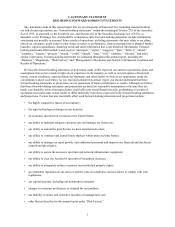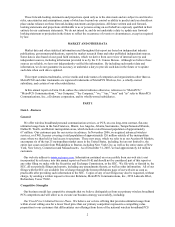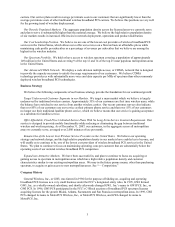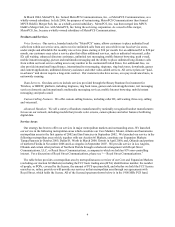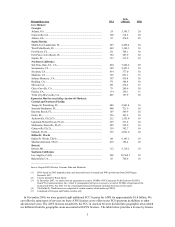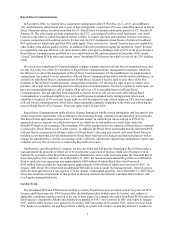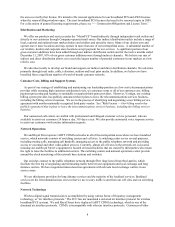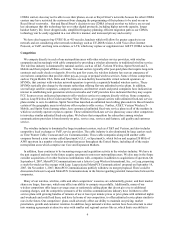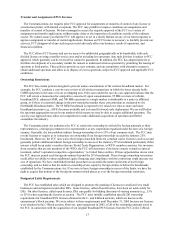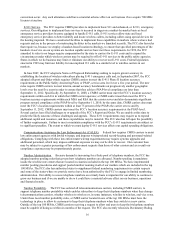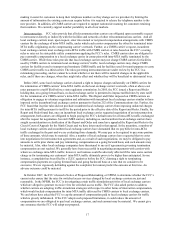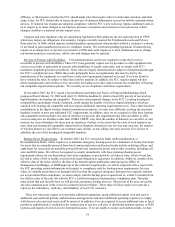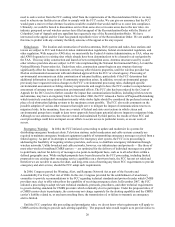Metro PCS 2007 Annual Report Download - page 22
Download and view the complete annual report
Please find page 22 of the 2007 Metro PCS annual report below. You can navigate through the pages in the report by either clicking on the pages listed below, or by using the keyword search tool below to find specific information within the annual report.
11
associated policies govern, among other things, the allocation and licensing of spectrum, the ownership and transfer
of control or assignment of wireless licenses, the ongoing technical, operational and service requirements under
which wireless licensees must operate, the timing and scope of network construction, the rates, terms and conditions
of service, the protection and use of customer information, roaming policies, the provision of certain services, such
as E-911, and the interconnection of communications networks.
Broadband Spectrum Allocations
Cellular Spectrum. Starting in the 1980’ s, the FCC awarded two cellular licenses in the 800 MHz band on a
metropolitan statistical area, or MSA, and rural service area, or RSA, basis with 25 MHz of spectrum for each
license. There are 306 MSAs and 428 RSAs in the United States. Metropolitan statistical areas and rural service
areas are defined by the Office of Management and Budget and the FCC, respectively.
PCS Spectrum. In 1995, the FCC allocated an additional 120 MHz of radio spectrum in the 1.9 GHz band for
broadband PCS. The FCC divided the 120 MHz of spectrum into two 30 MHz blocks licensed on a Major Trading
Area, or MTA, basis, and one 30 MHz block and three 10 MHz blocks licensed on a Basic Trading Area, or BTA,
basis. Under the broadband PCS licensing plan, the United States and its possessions and territories are divided into
493 BTAs, all of which are included within 51 MTAs. Both MTAs and BTAs are defined by Rand McNally &
Company. Licensees of PCS services can compete with cellular services. Many of our competitors utilize a
combination of cellular and broadband PCS spectrum to provide their services.
AWS-I Spectrum. In 2005, the FCC allocated an additional 90 MHz of spectrum to be used for advanced
wireless services, or AWS. The FCC divided the 90 MHz of spectrum into two 10 MHz and one 20 MHz blocks
licensed on a regional economic area grouping, or REAG, basis, one 10 MHz and one 20 MHz block licensed on an
economic area, or EA, basis, and a 20 MHz block licensed on a MSA basis and RSA basis. Under the AWS band
plan, the United States is divided into 176 EAs, 12 REAGs, and 734 MSA/RSAs. The EAs are geographic areas
defined by the Regional Economic Analysis Division of the Bureau of Economic Analysis, U.S. Department of
Commerce. REAGs are collections of EAs. Licensees of AWS spectrum can offer services in competition with
broadband PCS and cellular licensees and offer other advanced wireless services as well.
700 MHz Spectrum. In 2007, the FCC adopted rules establishing a band plan, performance requirements, and
services rules for an additional 62 MHz of spectrum in the 700 MHz band. The band plan provides for two 12 MHz
paired licenses and one 6 MHz unpaired license licensed on a MSA/RSA or EA basis, one 22 MHz paired license
licensed on a REAG basis, and one 10 MHz paired license on a nationwide basis as part of a private/public safety
partnership. The auction of the 22 MHz spectrum block utilizes package or combination bidding in order to facilitate
the aggregation of the REAG license areas into a single nationwide license. The 10 MHz nationwide license requires
the licensee to fund the construction of a nationwide interoperable broadband network for public safety on a
nationwide public safety license and provide public safety with priority access during emergencies to the 10 MHz of
700 MHz spectrum owned by the licensee. The terms and conditions initially placed by the FCC on the 22 MHz
license require the licensee to provide a network platform that is generally open to third-party wireless devices and
applications, or an Open Network Platform, by allowing consumers to use the handset of their choice and download
and use the applications of their choice, subject to certain network management conditions that are intended to allow
the licensee to protect the network from harm. A number of parties have asked the FCC to clarify and reconsider
certain aspects of the FCC’ s 700 MHz rules. Further, an industry association, CTIA, and several other parties have
filed appeals of the FCC’ s Order challenging the requirement that the 22 MHz license provide an Open Network
Platform, and the rules governing so-called “designated entities”, or “DEs”, which include businesses controlled by
minorities, women, small businesses and rural telephone companies with respect to the auction of the 700 MHz
spectrum. The initial auction (Auction No. 73) for 700 MHz spectrum commenced on January 24, 2008 and we
submitted an application to participate in, and we were found by the FCC to be qualified to bid in, the auction. As of
February 28, 2008, Auction No. 73 is still on-going.
Future Allocations. The FCC also has other broadband wireless spectrum allocation proceedings in process. In
2004, the FCC sought comment on service rules for an additional 20 MHz of AWS spectrum, or AWS-2, in the
1915-1920 MHz, 1995-2000 MHz, 2020-2025 MHz and 2175-2180 MHz bands. Also, on September 2007, the FCC
released a Notice of Proposed Rulemaking seeking comment on proposed service rules for the 2155-2175 MHz
band, or AWS-3, which has been allocated for fixed and mobile services, including AWS. These proposed
allocations present certain unique spectrum clearing and interference issues, and we cannot predict with any
certainty the likely configuration, conditions or timing of these proposed allocations. The FCC also may undertake
proceedings in the future to allocate additional spectrum for wireless services or to change the rules relating to


